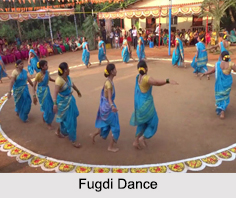 Fugdi Dance is a folk dance of Maharashtra and Goa which is only performed by women of Hindu, Christian and tribal communities. This dance does not need any musical instrument and performed on sounds of clapping made by women folks. This dance is weaved around the daily life and struggles of these women. The Fugdi dance is performed by the women in the Konkan region during various religious and social occasions like Ganesh Chaturthi, Dhalo festival and Vrata of Goddess Mahalakshmi. According to certain historical facts, this dance style is said to have been created from few ancient Maharashtrian and Goan traditions. Fugdi is generally performed during the month of Bhadrapada, an occasion for the women to take a temporary break from their normal, monotonous schedule.
Fugdi Dance is a folk dance of Maharashtra and Goa which is only performed by women of Hindu, Christian and tribal communities. This dance does not need any musical instrument and performed on sounds of clapping made by women folks. This dance is weaved around the daily life and struggles of these women. The Fugdi dance is performed by the women in the Konkan region during various religious and social occasions like Ganesh Chaturthi, Dhalo festival and Vrata of Goddess Mahalakshmi. According to certain historical facts, this dance style is said to have been created from few ancient Maharashtrian and Goan traditions. Fugdi is generally performed during the month of Bhadrapada, an occasion for the women to take a temporary break from their normal, monotonous schedule.
Performance of Fugdi Dance
The women sing and dance while enacting varied formations – in a circle or in rows. Usually women in the villages dance Fugdi in circles and women in forest settlements formulate rows. The dance starts with invocation to Hindu Gods. The pace is slow in the beginning, but soon attains a fast pace, reaching climax.
In Fugdi dance, the girls stand facing each other. Crossing their arms they join their palms and lean back with their feet together. While doing so, they outstretch their arms and whirl round as far and as long as they can and then parting ways to perfection. These Phungadi dances have innumerable variations.
No musical instrument or accompaniment is found with the dance, but special Fugdi songs are innumerable.
Types of Fugdi Dance
There are two sub-forms of Fugdi Dance, namely "Katti Fugdi" and "Kalshi Fugdi". Katti Fugdi is a performance with coconut shells in hands whereas Kalshi Fugdi is performed with Kalash (water pitcher) in hands. The water pitcher is a symbol of womb and they blow into it to give it life.
Costumes of Fugdi Dance
While the Hindu counterparts use colourful sarees, the Christian used a chequered red saree with a knot being tied on the right shoulder. A white dupatta is tied around the waist. Since they performed the Fugdi as part of their daily routine, these clothes were used not only for work but also to dance.



















